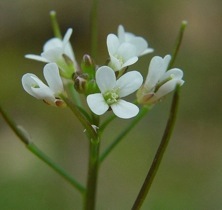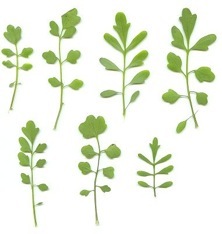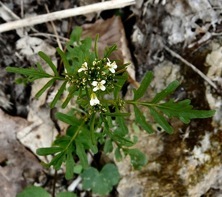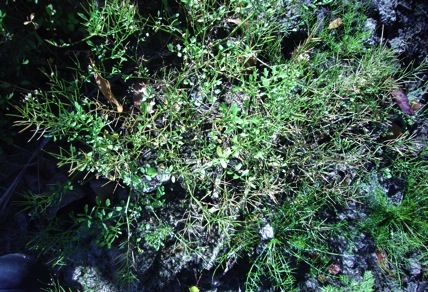Cardamine pensylvanica: Petite Pot Herb
The first time I saw Bittercress I knew it had to be an edible. I just didn’t know which one.
How did I know? Plants are in families and it looked like a lot of wild edible plants in the Brassica family, or Cruciferae: Scrawny, leggy, skinny little leaves, minute four-petaled flowers, seeds in a pod on stems, peppery leaves. The only odd element was I found it in very wet soil, next to a stream. Come to find out, it likes rich, damp soil, and a close relative that looks very much alike, likes dry terrain.
 Cardamine pensylvanica (yes one “N” in pensylvanica thanks to the dead language of Latin) really isn’t bitter, or at least the ones I’ve had haven’t been. Actually several Cardamines are available in the United States and at least four in Florida, C. pensylvanica, C. parvifolia, C flexuosa and C. concatenata. Other ones found and consumed in the U.S. are C. hirsuta, C. amara, C. oligosperma and C. pratensis, for leaves; and C. rhomboidea and C. diphylla for their leaves and/or roots.
Cardamine pensylvanica (yes one “N” in pensylvanica thanks to the dead language of Latin) really isn’t bitter, or at least the ones I’ve had haven’t been. Actually several Cardamines are available in the United States and at least four in Florida, C. pensylvanica, C. parvifolia, C flexuosa and C. concatenata. Other ones found and consumed in the U.S. are C. hirsuta, C. amara, C. oligosperma and C. pratensis, for leaves; and C. rhomboidea and C. diphylla for their leaves and/or roots.
It is not at all unusual for the roots of such plants to be ground up and mixed with vinegar and salt to make a horseradish kind of sauce. I’ve done it often with the roots of the Lepidium virginicum, or Poor Man’s Pepper Grass.
 If you find a Cardamine in Florida growing where it is quite dry it is probably the C. parvifolia. If wet, then probably the C. hirsuta (see separate entry.) Incidentally, there are four endangered species of Cardamine in the U.S. (C. constancei, C. incisa, C. micranthera and C. pattersonii) so harvest conscientiously.
If you find a Cardamine in Florida growing where it is quite dry it is probably the C. parvifolia. If wet, then probably the C. hirsuta (see separate entry.) Incidentally, there are four endangered species of Cardamine in the U.S. (C. constancei, C. incisa, C. micranthera and C. pattersonii) so harvest conscientiously.
While C. pensylvanica is the most common locally the only native one is C. concatenata, or Cutleaf Bittercress. The Iroquois used it as food, raw, with salt or cooked. It was also used as a medicine. They mashed the roots and used them to treat headaches, colds, to encourage the appetite, for heart problems and injuries. It was also considered slightly hallucinogenic.
 The botanical name, Cardamine pensylvanica, is said kar-DAM-in-ee pen-sil-VAN-ee-ka. You will also see kar-da-MY-neez, which is the British way of saying it. Cardamine is from the Greek word kardamis, for a kind of cress. Contemporary Greeks call cress κάδαμο (KAR-tha-moe.) Pensylvanica means “of Pennsylvania, or Eastern North America. Parvifolia (par-vee-FOH-lee-uh) means small leaf. Concatenata (kon-kan-teh-NAH-tuh) means linked or chained together. Hirsuta means hairy, referring to the lower stems.
The botanical name, Cardamine pensylvanica, is said kar-DAM-in-ee pen-sil-VAN-ee-ka. You will also see kar-da-MY-neez, which is the British way of saying it. Cardamine is from the Greek word kardamis, for a kind of cress. Contemporary Greeks call cress κάδαμο (KAR-tha-moe.) Pensylvanica means “of Pennsylvania, or Eastern North America. Parvifolia (par-vee-FOH-lee-uh) means small leaf. Concatenata (kon-kan-teh-NAH-tuh) means linked or chained together. Hirsuta means hairy, referring to the lower stems.
Thee are some 150 species in the genus and are found at every location on the rotation except the Antarctic. The leaves vary greatly from plant to plant, species to species, from minute to medium-sized, pinnate to bipinnate, basal to cauline (growing on the upper part of the stem.) The edges of the leaves smooth or toothy. And you have just to got to love those arguing botanists. The genus Dentaria and the genus Cardamine are the same genus, just different egos at conflict.
Under cultivation C. pensylvanica can be coaxed to grow to more than a yard high and wide. A perennial herb, it can be trained into round shrub. Oddly, when raised intentionally it does not like to be wet and one has to water it moderately.
Green Deane’s “Itemized” Plant Profile
IDENTIFICATION:
Scraggly plant to two feet, weak taproot, flowers white, tiny, about 1/16 to 1/8 inch across. Silique seed pods, elongate, narrow, middle membrane, many seeds. Basal leaves and middle leaves long, deeply lobed, with great variation. Leaves have three distinct veins. Stems multiple, upright or spreading, branched, green to purplish, round to angled in cross-section, hairy towards base. Upper stem can be non-hair, lower stem can have fuzz.
TIME OF YEAR:
Flowers April to October, leaves and seed pods for several months
ENVIRONMENT:
C. pensylvanica prefers wet feet, C. parvifolia likes it dry
METHOD OF PREPARATION:
Young leaves raw, older leaves cooked, seed pods raw or pickled, some roots can make a good horseradish substitute.



Hey Greene! I took your class in Florida and now live in Tennessee and you still seem to be the most reliable one to ask questions. I found multiple wild edibles/medicinals in my yard here and it took a while to figure out what the plant with the seed pods was. Well now i know it is bittercress. I believe hairy bittercress. My question is are all bittercress used the same way or does it vary? Also any look alikes? Thanks for all the info brother.
There are a multitude of little mustards in the spring. If you take a picture and post it on the Green Deane Forum UFO page I’m sure we can identify it quickly.
We have a lot of the hoary bittercress around hear and I was wondering if you knew if it’s properties were the same as watercress or not?
If you mean Cardamine hirsuta it is in a different genus but is distantly related to Nasturtium officinale so there should be some elements in common but they are not the same.
hello… love your site! i live on the coast of oregon and was just talking to a friend who runs a nursery and she just told me popweed is edible! looked it up and im 95% sure we have cardamine hirsuta here. little tiny leaves and flowers and they shoot seeds at you in the fall…. quite far too! been smacked in the face more times than i can count by flying seeds. so my question is is the whole plant edible and are there any toxic look alikes you know of?
If it is in the mustard family, as cardamine are, the whole plant is edible though it may not be palatable.
I noticed the article said it could be hallucinogenic but I can’t find much info about that elsewhere.. Could just eating a salad with the greens cause this effect?
Only one species, Cardamine concatenata, was considered slightly hallucinogenic. It’s native and was eaten by the Iroquois.
It’s mid-January in NE PA. And I am finding Pennsylvania bittercress growing in abandoned lots. Good in salads along with wild onion greens, which are also growing presently.